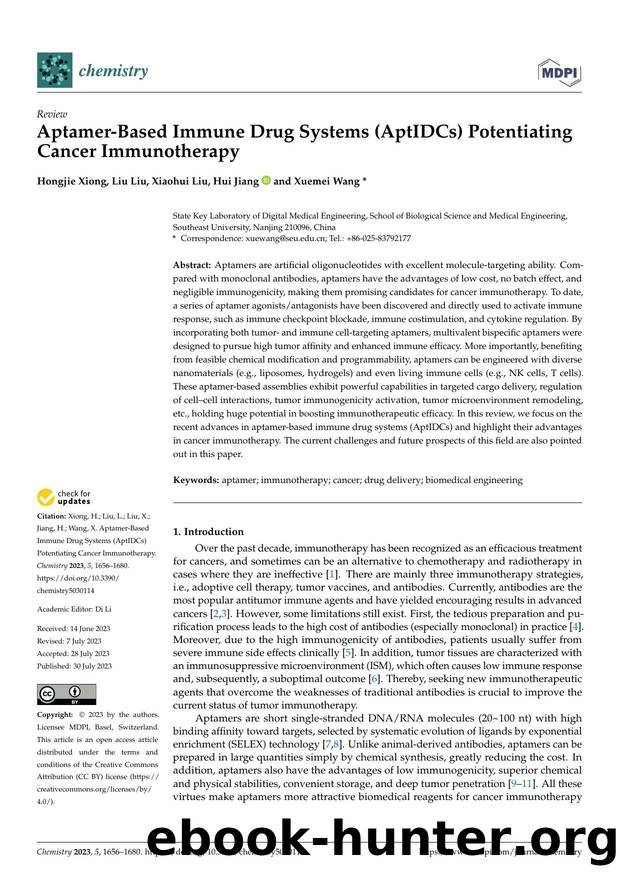Aptamer-Based Immune Drug Systems (AptIDCs) Potentiating Cancer Immunotherapy by Hongjie Xiong Liu Liu Xiaohui Liu Hui Jiang & Xuemei Wang

Author:Hongjie Xiong, Liu Liu, Xiaohui Liu, Hui Jiang & Xuemei Wang
Format: pdf
Tags: Aptamers are artificial oligonucleotides with excellent molecule-targeting ability. Compared with monoclonal antibodies, aptamers have the advantages of low cost, no batch effect, and negligible immunogenicity, making them promising candidates for cancer immunotherapy. To date, a series of aptamer agonists/antagonists have been discovered and directly used to activate immune response, such as immune checkpoint blockade, immune costimulation, and cytokine regulation. By incorporating both tumor- and immune cell-targeting aptamers, multivalent bispecific aptamers were designed to pursue high tumor affinity and enhanced immune efficacy. More importantly, benefiting from feasible chemical modification and programmability, aptamers can be engineered with diverse nanomaterials (e.g., liposomes, hydrogels) and even living immune cells (e.g., NK cells, T cells). These aptamer-based assemblies exhibit powerful capabilities in targeted cargo delivery, regulation of cell–cell interactions, tumor immunogenicity activation, tumor microenvironment remodeling, etc., holding huge potential in boosting immunotherapeutic efficacy. In this review, we focus on the recent advances in aptamer-based immune drug systems (AptIDCs) and highlight their advantages in cancer immunotherapy. The current challenges and future prospects of this field are also pointed out in this paper., aptamer; immunotherapy; cancer; drug delivery; biomedical engineering
Download
This site does not store any files on its server. We only index and link to content provided by other sites. Please contact the content providers to delete copyright contents if any and email us, we'll remove relevant links or contents immediately.
Application of a Novel Technique for Clinical Evaluation of Nitric Oxide-Induced Free Radical Reactions in ICU Patients by Unknown(708)
Rosenâs Emergency Medicine Concepts and Clinical Practice by Ron Walls; Robert Hockberger; Marianne Gausche-Hill; Timothy B. Erickson; Susan R. Wilcox(583)
Oxidative damage to surfactant protein D in pulmonary diseases by Vitality Starosta1 & Matthias Griese1†(426)
Social Science Perspectives on Global Public Health by Vincent La Placa & Julia Morgan(388)
Constructing Canine Consent; Conceptualising and Adopting a Consent-focused Relationship with Dogs by ERIN JONES(342)
Organic Chemistry: An Acid - Base Approach by MICHAEL SMITH(315)
ADVANCED EMERGENCY CARE AND TRANSPORTATION OF THE SICK AND INJURED by Unknown(292)
Saunders Nursing Drug Handbook 2024 - E-Book by Unknown(280)
Diagnostic and Statistical Manual of Mental Disorders, Fifth Edition, Text Revision (DSM-5-TR(tm)) by Unknown(275)
Access to Medicines and Vaccines in the South : Coherence of Rules and Policies Applied by the European Union Commission by Stephen Kingah(272)
Davis's Comprehensive Manual of Laboratory and Diagnostic Tests with Nursing Implications by Unknown(264)
Socio-Life Science and the COVID-19 Outbreak : Public Health and Public Policy by Makoto Yano; Fumihiko Matsuda; Anavaj Sakuntabhai; Shigeru Hirota(260)
Human Microanatomy; Cell Tissue and Organ Histology with Celebrity Medical Histories by Stephen A. Stricker(259)
Berne and Levy Physiology E-Book by Unknown(248)
Replacing the Dead by Mie Nakachi;(246)
Handbook of Skin Disease Management by Jiyad Zainab;Flohr Carsten; & Carsten Flohr(243)
The Pocket Guide to Sensorimotor Psychotherapy in Context (Norton Series on Interpersonal Neurobiology) by Pat Ogden(238)
Deep Learning and Medical Applications by Unknown(234)
Advances and Technical Standards in Neurosurgery by Unknown(229)
